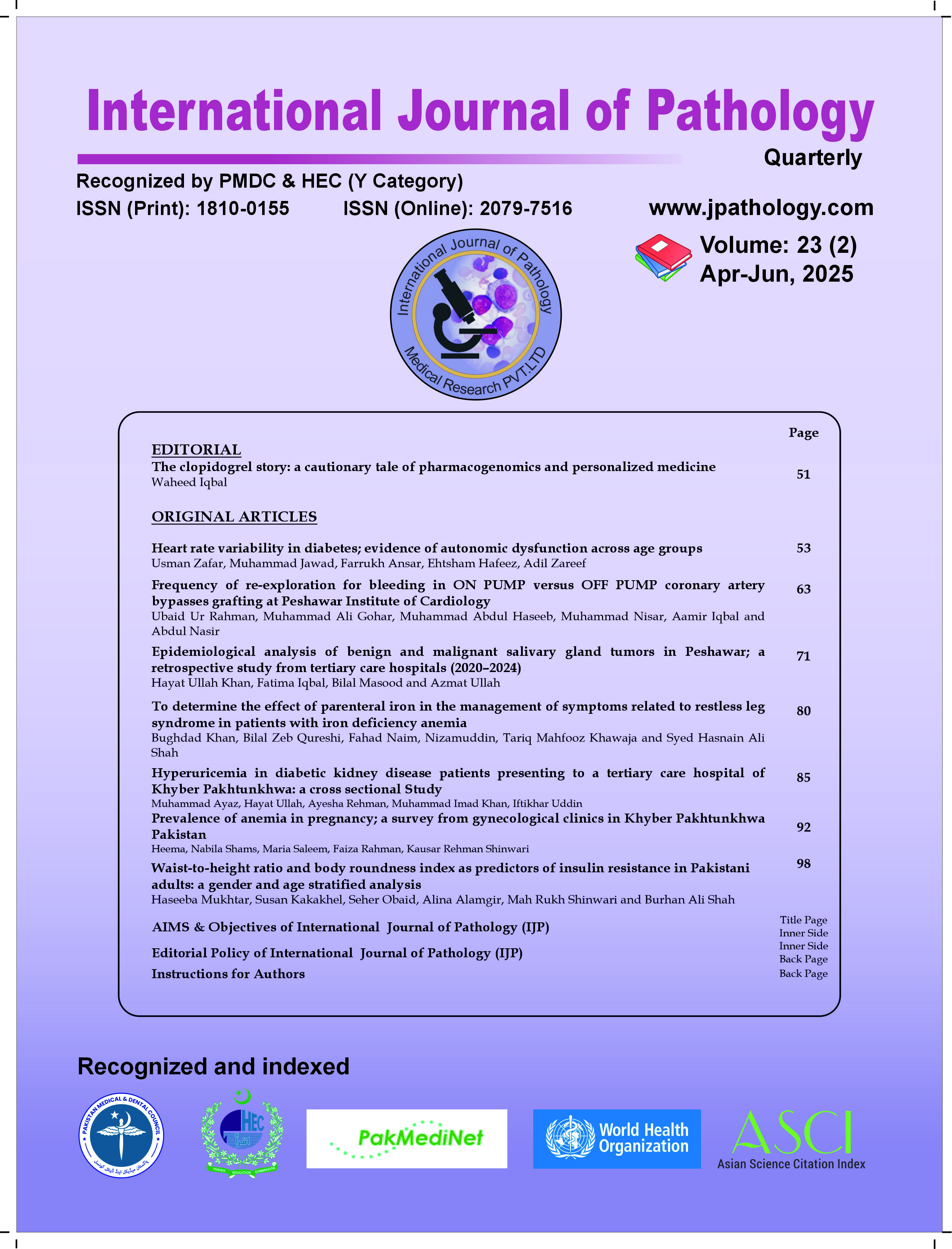Heart rate variability in diabetes
evidence of autonomic dysfunction across age groups
DOI:
https://doi.org/10.59736/IJP.23.02.948Keywords:
Autonomic Dysfunction, Cardiovascular Risk, Diabetes Mellitus, Heart RateAbstract
Background: Heart rate variability (HRV) serves as a non-invasive marker of autonomic nervous system function. In individuals with diabetes mellitus, cardiac autonomic neuropathy is a recognized complication that may manifest as reduced HRV and increased heart rate (HR). This study aimed to assess differences in HR and HRV between diabetic and non-diabetic individuals and explore age-related variations.
Methods: A total of 64 subjects were included, comprising 33 individuals with diabetes and 31 non-diabetic controls. Short-term ECG recordings were analyzed to calculate average HR and HRV. Participants were further divided into ten age groups spanning 26–85 years, and subgroup analyses were performed to examine trends across age brackets.
Results: Diabetic participants had a higher average heart rate (86 bpm) compared to non-diabetics (77 bpm), along with significantly lower HRV (0.0185 vs. 0.0333). Age-stratified analyses revealed a consistent pattern of higher HR and lower HRV among diabetic individuals across most age groups. In the 41–45 age group, diabetics exhibited an average HR of 89 bpm and HRV of 0.0179, whereas non-diabetics had 77 bpm and 0.0358, respectively. in the 56–60 age group, diabetic participants had an average heart rate of 85 bpm and an HRV of 0.0136, whereas non-diabetic participants had a lower average heart rate of 73 bpm and a higher HRV of 0.0262.
Conclusion: This study reveals that diabetes is associated with reduced autonomic flexibility, as reflected by lower HRV and elevated HR. These alterations suggest early cardiac autonomic dysfunction, which may increase cardiovascular risk. Routine HRV assessment could enhance clinical monitoring and risk stratification in diabetic patients, particularly when combined with emerging digital health technologies.
References
Tiwari R, Kumar R, Malik S, Raj T, Kumar P. Analysis of Heart Rate Variability and Implication of Different Factors on Heart Rate Variability. Curr Cardiol Rev. 2021; 17(5):e160721189770. Doi: 10.2174/1573403X16999201231203854.
Agorastos A, Mansueto AC, Hager T, Pappi E, Gardikioti A, Stiedl O. Heart Rate Variability as a Translational Dynamic Biomarker of Altered Autonomic Function in Health and Psychiatric Disease. Biomedicines. 2023 May 30; 11(6):1591. doi: 10.3390/biomedicines11061591
Sudo SZ, Montagnoli TL, Rocha BS, Santos AD, de Sá MPL, Zapata-Sudo G. Diabetes-Induced Cardiac Autonomic Neuropathy: Impact on Heart Function and Prognosis. Biomedicines. 2022 Dec 15; 10(12):3258. Doi: 10.3390/biomedicines10123258.
Tuttolomondo A, Del Cuore A, La Malfa A, Casuccio A, Daidone M, Maida CD, et al. Assessment of heart rate variability (HRV) in subjects with type 2 diabetes mellitus with and without diabetic foot: correlations with endothelial dysfunction indices and markers of adipo-inflammatory dysfunction. Cardiovasc Diabetol. 2021 Jul 14; 20(1):142. Doi: 10.1186/s12933-021-01337-z.
Liu R, Li L, Shao C, Cai H, Wang Z. The Impact of Diabetes on Vascular Disease: Progress from the Perspective of Epidemics and Treatments. J Diabetes Res. 2022 Apr 8; 2022:1531289. Doi: 10.1155/2022/1531289.
Hu MX, Lamers F, de Geus EJ, Penninx BW. Influences of lifestyle factors on cardiac autonomic nervous system activity over time. Prev Med. 2017 Jan; 94:12-19. Doi: 10.1016/j.ypmed.2016.11.003.
Basri AM, Turki AF. Evaluating Heart Rate Variability as a Biomarker for Autonomic Function in Parkinson's Disease Rehabilitation: A Clustering-Based Analysis of Exercise-Induced Changes. Medicina (Kaunas). 2025 Mar 17; 61(3):527. Doi: 10.3390/medicina61030527.
Shaffer F, Ginsberg JP. An Overview of Heart Rate Variability Metrics and Norms. Front Public Health. 2017 Sep 28; 5:258. Doi: 10.3389/fpubh.2017.00258.
Shan X., Yang E.H., Zhou J., Chang V.W.C. Human-Building Interaction under Various Indoor Temperatures through Neural-Signal Electroencephalogram (EEG) Methods. Build. Environ. 2018; 129:46–53. doi: 10.1016/j.buildenv.2017.12.004
Gruionu G, Aktaruzzaman M, Gupta A, Nowak TV, Ward M, Everett TH 4th. Heart rate variability parameters indicate altered autonomic tone in subjects with COVID-19. Sci Rep. 2024 Dec 28; 14(1):30774. Doi: 10.1038/s41598-024-80918-w.
Serra C, Sestu A, Murru V, Greco G, Vacca M, Scuteri A. Diabetes Affects the Relationship between Heart Rate Variability and Arterial Stiffness in a Gender-Specific Manner. J Clin Med. 2022 Aug 23; 11(17):4937. Doi: 10.3390/jcm11174937.
Benichou T, Pereira B, Mermillod M, Tauveron I, Pfabigan D, Maqdasy S, et al. Heart rate variability in type 2 diabetes mellitus: A systematic review and meta-analysis. PLoS One. 2018 Apr 2; 13(4):e0195166. Doi: 10.1371/journal.pone.0195166.
Shah A.S., Isom S., D’Agostino J.R., Dolan L.M., Dabelea D., Imperatore G., et al. Longitudinal Changes in Arterial Stiffness and Heart Rate Variability in Youth-Onset Type 1 Versus Type 2 Diabetes: The SEARCH for Diabetes in Youth Study. Diabetes Care. 2022; 45:1647–1656. doi: 10.2337/dc21-2426
Yu TY, Lee MK. Autonomic dysfunction, diabetes and metabolic syndrome. J Diabetes Investig. 2021 Dec; 12(12):2108-2111. Doi: 10.1111/jdi.13691.
Tang T, Sun X, Zhang X, Li J, Wang M, Hui C, Cheng Y, Kong X, Sun Y. 25-hydroxyvitamin D as a predictor of reduced heart rate variability in elderly patients with diabetes mellitus. Front Endocrinol (Lausanne). 2025 Apr 30; 16:1556345. Doi: 10.3389/fendo.2025.1556345.
Ribeiro ASF, Zerolo BE, López-Espuela F, Sánchez R, Fernandes VS. Cardiac System d generalizability uring the Aging Process. Aging Dis. 2023 Aug 1; 14(4):1105-22. Doi: 10.14336/AD.2023.0115.
Kanagala A, Harsoda JM. Sympathetic Overactivity and Parasympathetic Impairment in Type 2 Diabetes: An Analysis of Cardiovascular Autonomic Functions. Cureus. 2024 May 3; 16(5):e59561. Doi: 10.7759/cureus.59561.
Ikeda S, Shinohara K, Enzan N, Matsushima S, Tohyama T, Funakoshi K, Kishimoto J, Itoh H, Komuro I, Tsutsui H. A higher resting heart rate is associated with cardiovascular event risk in patients with type 2 diabetes mellitus without known cardiovascular disease. Hypertens Res. 2023 May;46(5):1090-1099. doi: 10.1038/s41440-023-01178-1.
Shah AS, Lampert R, Goldberg J, Bremner JD, Li L, Thames MD, Vaccarino V, Shah AJ. Alterations in heart rate variability are associated with abnormal myocardial perfusion. Int J Cardiol. 2020 Apr 15; 305:99-105. Doi: 10.1016/j.ijcard.2020.01.069.
Castiglioni P, Faini A, Nys A, De Busser R, Scherrenberg M, Baldussu E, et al,. Heart Rate Variability for the Early Detection of Cardiac Autonomic Dysfunction in Type 1 Diabetes. Front Physiol. 2022 Jun 30; 13:937701. Doi: 10.3389/fphys.2022.937701.
Bajwa J, Munir U, Nori A, Williams B. Artificial intelligence in healthcare: transforming the practice of medicine. Future Healthc J. 2021 Jul; 8(2):e188-e194. Doi: 10.7861/fhj.2021-0095.
Odeh VA, Chen Y, Wang W, Ding X. Recent Advances in the Wearable Devices for Monitoring and Management of Heart Failure. Rev Cardiovasc Med. 2024 Oct 28; 25(10):386. Doi: 10.31083/j.rcm2510386.
El-Sofany H, Bouallegue B, El-Latif YMA. A proposed technique for predicting heart disease using machine learning algorithms and an explainable AI method. Sci Rep. 2024 Oct 7; 14(1):23277. Doi: 10.1038/s41598-024-74656-2.
Martínez-Sellés M, Marina-Breysse M. Current and Future Use of Artificial Intelligence in Electrocardiography. J Cardiovasc Dev Dis. 2023 Apr 17; 10(4):175. Doi: 10.3390/jcdd10040175.
Koçak B, Cuocolo R, dos Santos DP, Stanzione A, Ugga L. Must-have Qualities of Clinical Research on Artificial Intelligence and Machine Learning. Balkan Med J. 2023 Jan 23; 40(1):3-12. Doi: 10.4274/balkanmedj.galenos.2022.2022-11-51.
Downloads
Published
Issue
Section
License
Copyright (c) 2025 Usman Zafar, Muhammad Jawad, Farrukh Ansar, Ehtsham Hafeez, Adil Zareef

This work is licensed under a Creative Commons Attribution-NonCommercial 4.0 International License.
Readers may “Share-copy and redistribute the material in any medium or format” and “Adapt-remix, transform, and build upon the material”. The readers must give appropriate credit to the source of the material and indicate if changes were made to the material. Readers may not use the material for commercial purpose. The readers may not apply legal terms or technological measures that legally restrict others from doing anything the license permits.


